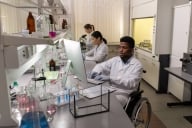You have /5 articles left.
Sign up for a free account or log in.
The recent threat to boycott an upcoming international chemistry conference because of its all-male speaking program reminds us how far we still have to go when it comes to women in the science, technology, engineering and math (STEM) fields. The challenge remains that many STEM professions remain male-dominated, especially in academia.
For well over a decade, the National Science Foundation has tried to move the needle on the gender gap in STEM disciplines by supporting efforts to recruit, hire and retain more female faculty. While these efforts have had some impact, the reality is that real success means more than numbers.
At the University of Cincinnati, with support from the NSF, we are taking a close look at the obstacles that female STEM faculty continue to face. Role models for women scientists are few and far between. Even with increasing numbers of women obtaining STEM doctoral degrees, they remain underrepresented in nearly all STEM academic positions -- and it is even worse for women of color.
We are finding that to attain the transformational outcomes that our universities and our nation need for a more diverse STEM professoriate, systemic change is necessary – specifically, we need to create a culture, climate and experience in higher education that allows women as well as men to thrive.
The family-friendly policies and recruitment efforts that many universities have adopted have certainly have been steps in the right direction.
However, what more pointedly nourishes and encourages career success is the opportunity to network and to be mentored. In male-dominated STEM departments, men, by and large, are able to network with ease. For women, those support systems are not a given.
Our preliminary survey data show that in our STEM departments a greater percentage of women seek formal mentoring relationships than do their male counterparts. We suspect that this is the case because women just do not have access to informal and natural avenues to connect with their colleagues.
Faculty and graduate students often establish relationships with mentors and collaborators through socializing after hours or at conferences. Many departments do not offer formal mentoring or networking systems, either for women or for men. But without these kinds of opportunities offered throughout the academy systemically, women face perennial challenges in gaining the visibility that they need for success and in learning how to negotiate expectations or how to find research partners on grants.
For both men and women in scientific, technological or medical research, networks matter today more than ever. They matter not just for a researcher’s individual career, but also for all of us if we want to maximize scientific collaboration to bring about the best advancements that science can offer. In an age of cross-disciplinary investigation, networks are the force that powers innovation and discovery.
While women especially do not have the opportunities to network with colleagues in the same way that their male counterparts do, the climate that remains so adverse to women does little to help men either ̶ many of whom have comparable child-care and home-care responsibilities to women these days. Going to work after work is fast becoming a viable option for no one.
So how can we achieve the systemic change needed to nurture supportive STEM networks? We must deliberately and thoughtfully change our culture that encourages women to become isolated in their jobs. The academy must develop a new tool kit to help both women and men create healthy, professional networks for advancement of both science and their own careers. These new approaches should include:
- intentional and proactive mentoring and sponsorship for everyone, not just hit-or-miss for those who can routinely show up at social gatherings;
- well-thought-out and documented expectations for professional behavior;
- programs that introduce STEM faculty to others connected to their disciplines;
- specific programming that teach faculty how to network.
We just concluded Women's History Month. It is time for higher education to write a new chapter in that history. Achieving the best science means creating pathways for all STEM researchers, whether man or woman, to collaborate, interact and learn from one another. It means more than educational opportunity and greater numbers entering the system. It means providing a structure that supports success.




